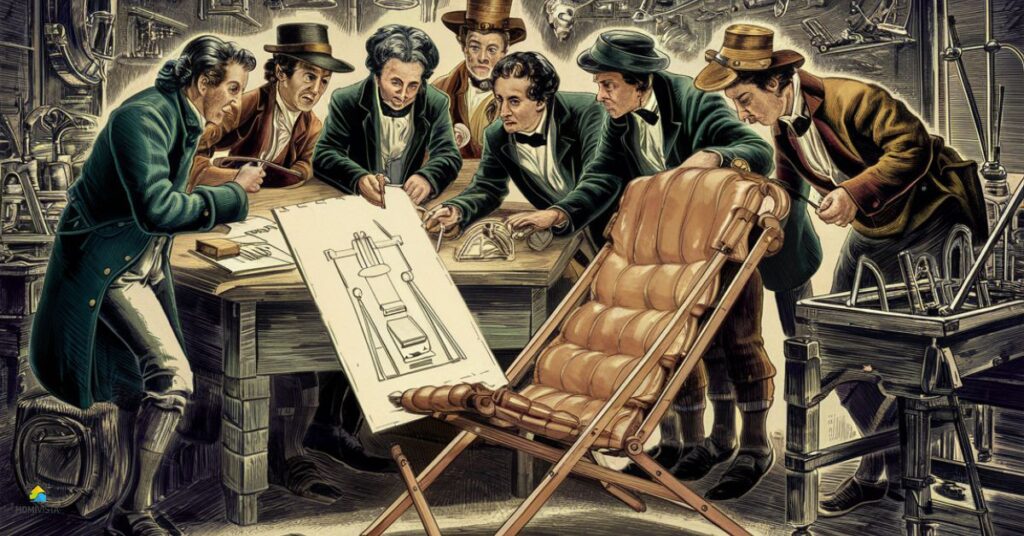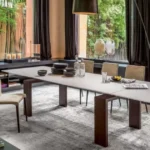Folding chairs are seats that can be folded for easy storage and transport. They come in various designs, often with metal or plastic frames and fabric seats. These chairs are popular for their portability and versatility, used both indoors and outdoors.
They are convenient for events, picnics, camping and extra seating at home. Despite their lightweight nature, they provide functional seating solutions and are available in a range of styles to suit different needs.
History of Folding Chairs
The history of folding chairs traces back to ancient civilizations, showcasing early ingenuity in portable seating solutions. Evolving through the ages, from Egyptian stools to Roman curule chairs, folding chairs have remained practical and symbolic fixtures in various cultures worldwide.
Early Evidence of Foldable Seating
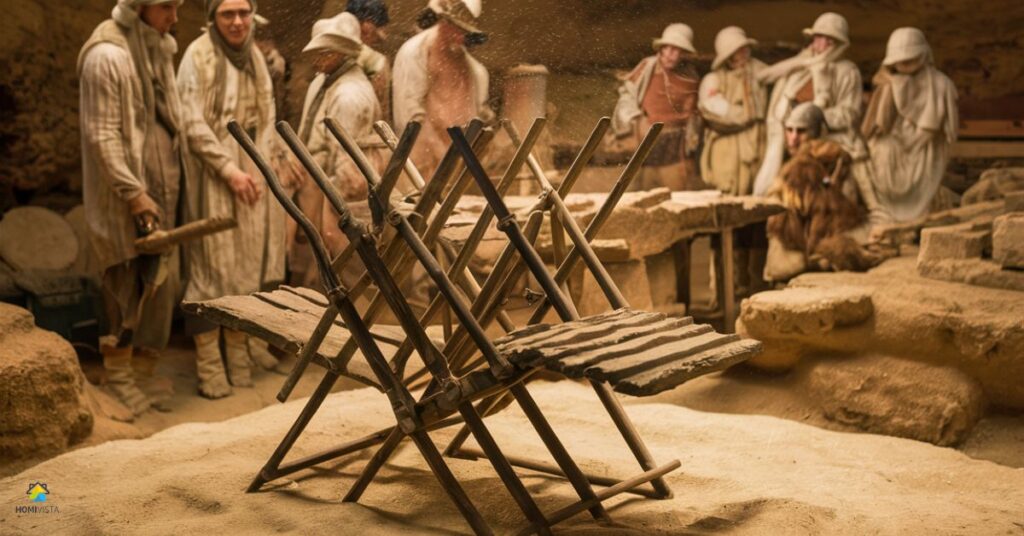
Ancient civilizations exhibited remarkable ingenuity in creating foldable seating solutions. Archaeological discoveries have revealed early examples of foldable stools and chairs made from materials such as wood, metal and animal hides. These early designs demonstrate a practical understanding of portability and space efficiency, traits that continue to define folding chairs today.
Folding Chairs in Ancient Civilizations (e.g., Egypt, Rome, China)
Egypt: The ancient Egyptians used folding stools made from wood and ivory, often adorned with intricate carvings and hieroglyphics. These stools were used by royalty and high-ranking officials during ceremonies and gatherings.
Rome: Roman folding chairs, known as “curule chairs” were symbols of authority and were used by magistrates and important figures. These chairs featured a distinctive X-shaped frame and were often made from luxurious materials like marble and bronze.
China: Chinese folding chairs date back to ancient times, with examples found in burial sites and historical records. These chairs were typically made from wood and bamboo, showcasing the Chinese emphasis on craftsmanship and functionality.
Read this: The Design And Decor Of Ethan Klein House: A Detailed Look
Medieval and Renaissance Folding Chairs
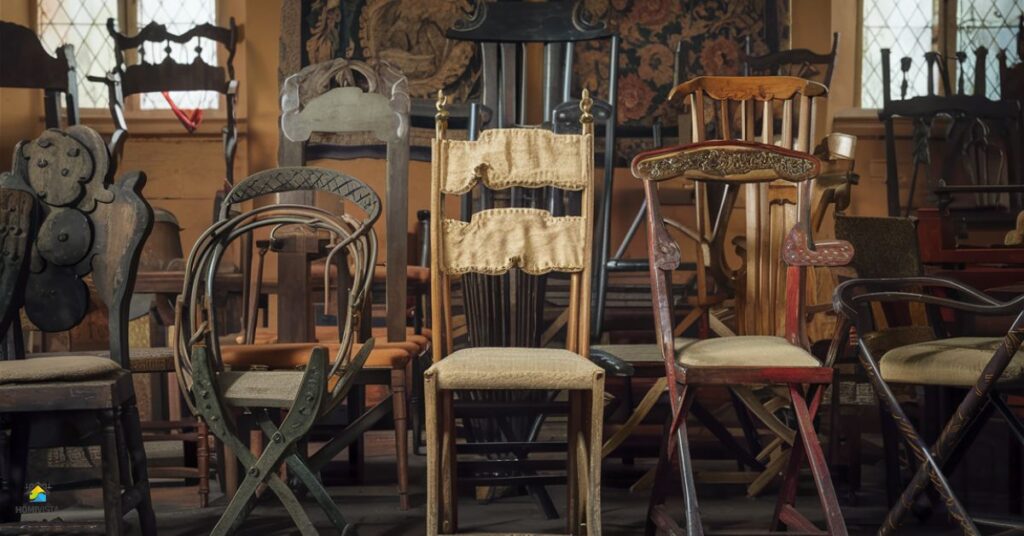
- In medieval times, folding chairs were essential for nobility and clergy.
- These chairs were often made of wood and adorned with intricate carvings.
- Portable and functional, they were used in courts, feasts and religious ceremonies.
- Medieval folding chairs reflected social status and were symbols of authority and luxury.
Renaissance Folding Chairs
- During the Renaissance, folding chairs evolved with artistic and technological advancements.
- Renaissance folding chairs showcased elegance, incorporating ornate designs and luxurious materials.
- They were used in palaces, theaters and grand events, adding to the ambiance of sophistication.
- Renaissance folding chairs symbolized refinement and cultural flourishing during this period.
Legacy and Influence
- The legacy of medieval and Renaissance folding chairs continues in modern design.
- Their functional yet decorative aspects inspire contemporary furniture makers.
- Elements of their craftsmanship and aesthetic appeal can be seen in today’s folding chair designs.
- These historical chairs left a lasting impact on seating culture and design evolution.
Modern Folding Chairs
Modern folding chairs combine lightweight materials, ergonomic designs and versatile functionality, offering convenient seating solutions for indoor and outdoor use in various settings.
Innovative Design and Materials
Modern folding chairs have transformed portable seating with their innovative designs and use of lightweight materials. They are typically constructed from durable materials like aluminum, plastic, or steel, ensuring longevity and ease of maintenance. These chairs are designed to be collapsible, making them compact for storage and convenient for transportation.
Enhanced Comfort and Functionality
Comfort is a key focus in modern folding chair design, with features such as padded seats and backrests providing ergonomic support. Some chairs even offer adjustable components like reclining backs or adjustable heights, catering to individual preferences. This focus on comfort enhances the overall functionality of modern folding chairs, making them suitable for extended use.
Versatile Applications and Popularity
Modern folding chairs find widespread use in various settings, including events, gatherings, offices, and outdoor activities. Their practicality, affordability, and versatility make them popular choices for extra seating solutions. With ongoing advancements in materials and design techniques, modern folding chairs continue to evolve to meet the diverse needs and preferences of users.
Design and Structure
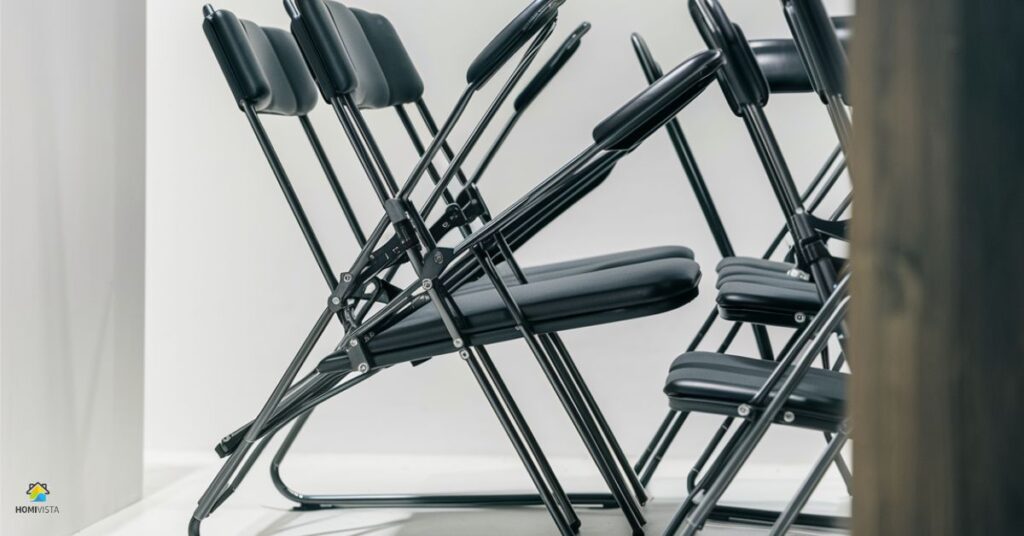
The design and structure of a folding chair are essential elements that contribute to its functionality, comfort and versatility. Here’s a detailed description of the design and structure of a folding chair:
Frame of Folding Chair
Materials: Folding chairs are typically constructed from various materials, including metal (such as steel or aluminum), wood and plastic. Each material offers different advantages in terms of durability, weight, and aesthetics.
Folding Mechanism: The frame of a folding chair incorporates a folding mechanism that allows the chair to be collapsed for storage or transport. Common mechanisms include hinges, collapsible designs or sliding components.
Seat and Backrest
Materials: The seat and backrest of folding chairs are commonly made from fabric, mesh, plastic or cushioned materials. These materials provide comfort and support during use.
Ergonomic Considerations: Modern folding chairs often incorporate ergonomic design principles to enhance user comfort. This may include contoured shapes, lumbar support and adjustable features to accommodate different body types.
Additional Features (optional)
Additional features in folding chairs, such as armrests, cup holders and storage pockets, enhance comfort and convenience, catering to diverse user needs and preferences.
Armrests: Some folding chairs come with built-in armrests, providing additional comfort and support for the arms and shoulders.
Cup Holders: Certain models of folding chairs may feature cup holders or other storage compartments for convenience during use.
Storage Pockets: Advanced folding chair designs may include storage pockets or pouches attached to the chair for holding small items such as phones, keys, or accessories.
Industrial Revolution to Modern Era
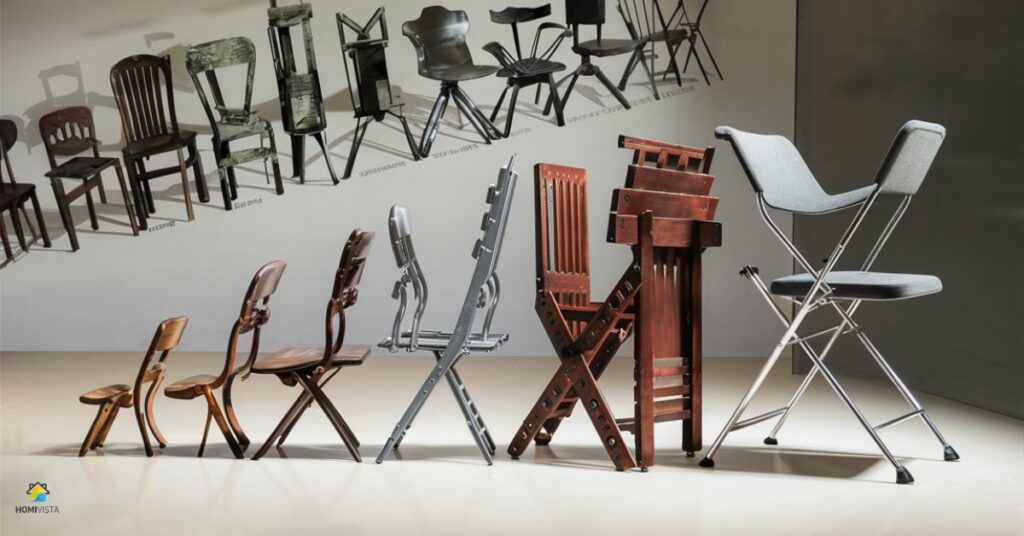
During the Industrial Revolution to the Modern Era, there were significant advancements in folding chair technology that transformed the way we think about portable seating.
Innovations in Materials and Manufacturing Techniques
During the Industrial Revolution to the Modern Era, there was a profound shift in the materials and manufacturing techniques used for folding chairs. Innovations such as the development of lightweight metals like aluminum and advancements in plastics revolutionized the industry. These materials not only enhanced the durability and strength of folding chairs but also made them more lightweight and portable, addressing the growing need for practical and versatile seating solutions.
Rise of Portable Seating for Outdoor Activities and Events
Simultaneously, this period saw a significant rise in the demand for portable seating, particularly for outdoor activities and events. Folding chairs became emblematic of convenience and comfort in various outdoor settings, including picnics, camping trips, sports events and social gatherings. Their foldable nature made them easy to transport and set up, providing individuals with a comfortable seating option wherever they went, contributing to the enjoyment of outdoor experiences.
20th Century Innovations
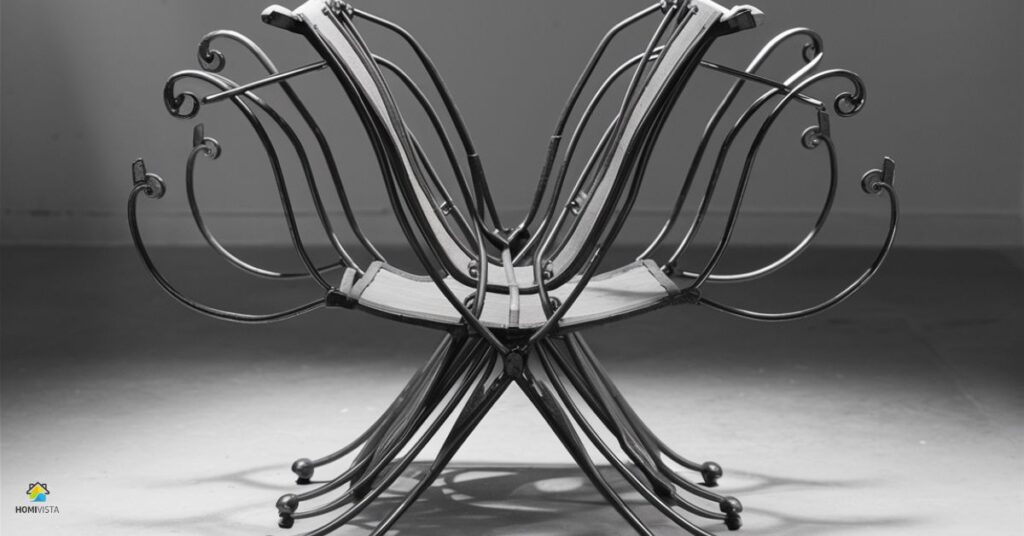
The 20th century marked a significant period of innovation and evolution for folding chairs, bringing about changes that revolutionized their design and utility.
Introduction of Lightweight Materials like Aluminum and Plastic
A major breakthrough during this era was the introduction of lightweight materials such as aluminum and advanced plastics in the manufacturing of folding chairs. This development transformed the industry by making chairs more portable, durable and versatile. Aluminum, in particular, became a favored choice due to its strength-to-weight ratio, corrosion resistance and ease of molding into various designs.
Advanced plastics offered similar benefits, providing a cost-effective alternative without compromising on quality. These lightweight materials played a pivotal role in making folding chairs more accessible and practical for a wide range of applications.
Role of Folding Chairs in Military, Camping and Leisure Activities
Folding chairs became indispensable in various spheres of life, especially in military operations, camping expeditions and leisure activities. In the military, folding chairs provided portable seating solutions for troops during deployments, training exercises and field operations.
Their compactness and ease of setup made them ideal for temporary seating arrangements in diverse environments. Similarly, in camping and outdoor adventures, folding chairs offered comfort and convenience, allowing individuals to relax and enjoy nature while minimizing bulk and weight.
Folding chairs became a staple in leisure activities such as picnics, beach outings, sports events and outdoor concerts, enhancing the overall experience for participants and spectators alike. The adaptability and functionality of folding chairs in these contexts underscored their enduring popularity and utility throughout the 20th century.
Specialized Folding Chairs for Various Purposes (e.g., Camping, Office, Events):
The 20th century saw the emergence of specialized folding chairs tailored for specific purposes. Camping chairs were designed with ruggedness and compactness in mind, while office chairs focused on ergonomic support and professional aesthetics. Event chairs were crafted for large gatherings, offering both comfort and durability. These specialized designs showcased the versatility of folding chairs in meeting diverse needs across different environments.
Also read: How Long Can An Ant Live Without Food: The Survival Strategies Of Tiny – Trash Rite
Frequently asked questions
What is a folding chair?
A folding chair is a portable seating solution that can be folded for easy storage and transport. It typically consists of a frame made from materials like metal or plastic, a seat and a backrest.
What are the benefits of using folding chairs?
Folding chairs offer several benefits, including space-saving storage, easy transportability, versatility for various settings and the ability to provide extra seating when needed.
What are the different types of folding chairs?
There are various types of folding chairs, including outdoor camping chairs, beach chairs, dining chairs, office chairs and specialized event chairs designed for venues like stadiums or conferences.
How do I clean and maintain a folding chair?
Cleaning and maintaining a folding chair usually involve wiping down the frame and seat with a mild soap solution and a damp cloth. Regular inspection of hinges or folding mechanisms for any signs of wear and tear is also recommended.
What weight capacity do folding chairs typically have?
Folding chairs come in a range of weight capacities, usually ranging from 200 to 500 pounds, depending on the chair’s design and materials. It’s essential to check the manufacturer’s specifications for the specific weight capacity of a folding chair.
Are there any safety considerations when using folding chairs?
Yes, safety considerations include ensuring the chair is fully unfolded and locked into place before use, avoiding exceeding the weight capacity, placing the chair on a stable surface and not leaning back excessively.
Can folding chairs be used outdoors?
Yes, many folding chairs are suitable for outdoor use. However, it’s essential to choose chairs made from weather-resistant materials like aluminum or plastic and store them properly when not in use to prolong their lifespan.
Are there eco-friendly options for folding chairs?
Yes, there are eco-friendly folding chairs made from sustainable materials such as bamboo, recycled plastic, or FSC-certified wood. These chairs are designed to reduce environmental impact while offering the same functionality and convenience as traditional folding chairs.
Conclusion
The invention of the folding chair is not attributed to a single individual but rather represents a collective evolution of seating design spanning centuries. Ancient civilizations such as Egypt, Rome and China showcased early versions of foldable seating, demonstrating a fundamental understanding of portability and practicality. These early examples laid the foundation for subsequent innovations in folding chair design during the Industrial Revolution and beyond.
During the 19th and 20th centuries, advancements in materials and manufacturing techniques led to the mass production and widespread availability of folding chairs. Lightweight materials like aluminum and plastic revolutionized the industry, making folding chairs more portable, durable, and accessible to a broader audience. While the specific inventor of the folding chair remains unclear, the continuous refinement and adaptation of this versatile seating solution have made it an indispensable fixture in homes, offices, events, and outdoor activities worldwide.

Meet Harry, our seasoned home decor specialist with three years of hands-on experience. His passion lies in crafting inviting spaces that reflect your style. From cozy corners to vibrant living rooms. Harry’s keen eye for design ensures every detail enhances the overall aesthetic. Trust him to turn your home into a personalized haven, blending functionality with flair.

